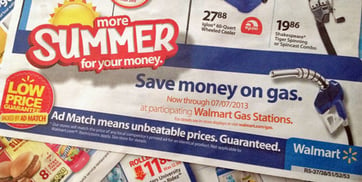It's one thing for a retail store to implement a program making the brand experience easier, more convenient, and a greater value for a specific customer segment. But when the program degrades the retail brand experience for higher margin customers and causes employee to act as if these customers are less trustworthy? Then, the program is a problem.
 The retail store is Walmart, and the program is the Walmart Ad Match Guarantee. That’s where they will match a competitor’s advertised price on the same item at Walmart.
The retail store is Walmart, and the program is the Walmart Ad Match Guarantee. That’s where they will match a competitor’s advertised price on the same item at Walmart.
On the surface, the Ad Match Guarantee is a great value enhancement strategy: it makes it convenient for bargain hunting customers to do all their shopping at Walmart while grabbing the greater value for certain items at other retailers. It obviously has revenue benefits for Walmart since it's not splitting a customer’s shopping cart with other retail stores.
I'm not an Ad Match Guarantee person. Probably should be, and once sort of was earlier in our marriage when I had my self-titled "Retail Project" spreadsheet to track prices for frequently purchased items at our primary retail stores. Great idea when I had more time.
My exclusive experience with the Ad Match Guarantee is getting caught behind someone at Walmart with a cartful of stuff segregated into non-coupon, coupon, and Ad Match items. Waiting for an Ad Match customer to get done with their "convenient" shopping experience typically sucks for those behind them in line. It can seem like forever as they take over managing the Walmart brand experience by informing the checker item-by-item on prices and how to check them out.
Brand Experience and Faulty Customer Segment Innovation
This is a prime example of a brand ceding control of its brand experience to one customer group to the detriment of the rest of its customers who aren't Ad Match shoppers.
The other night though, a benign Ad Match situation turned into an even more bizarre retail experience. We were behind a woman buying lots of groceries, although with only one Ad Match item – a pack of batteries. She saved them for last, telling the checker they were $4.89 at another retail store. Without any apparent hesitation, the checker took her word and rang the batteries up at that price, just at the Ad Match guarantee promises.
Then, it was our turn. We went to Walmart to buy two cases of Diet Coke. There were no cases (at $5.98) to be found, and two 12-packs were nearly $8.00. We did find 6-packs for $1.50 each on an end cap. We loaded up the cart with eight 6-packs; great price, but inconvenient to handle. We placed just one 6-pack on the belt. When it reached the checker, I told her we had 8 of them. She stopped everything to bend way over and count how many 6-packs we had in the cart and verify I was telling the truth.
Wait! You mean the shopper in front of us could tell the checker a price for an item at another retail store that could have been completely bogus, and the checker accepted it without hesitation, but she had to do the old 1,2,3 count for our Diet Coke to make sure we weren't lying?
Yup.
So, I told her I should have just grabbed the 12-packs and had her Ad Match to the $1.50 Diet Coke on the end caps – which would have been a lot more convenient. She mumbled that she couldn't Ad Match to the Diet Coke because it is stocked by Coca-Cola and not Walmart. She planned, however, to let somebody know about the $2 price gap.
Wait! You mean Walmart can Ad Match another retail store’s prices, but can't address a stupid pricing situation in its own retail store for the sake of MY shopper convenience?
Really?
3 Questions to Test Faulty Customer Segment Innovation
Here’s the lesson for all our brands: when your brand innovates a great program to enhance the brand experience for a certain segment of high volume customers (or any other customer segment), ask these questions:
- In what ways might the program compromise the brand experience for other customer segments?
- Does the program, by changing our typical processes, cause employee behaviors which don't make sense or won't be well received by other customer segments?
- Even if we can’t answers questions 1 and 2 right now, what do we have in place to monitor weird exceptions and negative brand experience situations the program causes?
To make our experience even more odd, when we got home, we realized the checker had not given the shopper in front of us all her groceries. The checker gave us a bag of lunch meat and Tapioca pudding belonging to the previous customer.
So the previous customer, by mucking up the end of her checkout experience with just one Ad Match Guarantee item, distracted the checker enough to wind up losing a $15 bag of groceries while saving maybe 60 cents on a pack of batteries.
That my friends, is every day crappy value. - Mike Brown
If you enjoyed this article, subscribe to the free Brainzooming email updates.
The Brainzooming Group helps make smart organizations more successful by rapidly expanding their strategic options and creating innovative plans they can efficiently implement. Email us at info@brainzooming.com or call us at 816-509-5320 to learn how we can help you enhance your strategy and implementation efforts.



